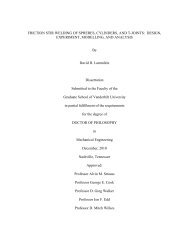manual
manual
manual
You also want an ePaper? Increase the reach of your titles
YUMPU automatically turns print PDFs into web optimized ePapers that Google loves.
Additional Recommended Guidelines for Treating<br />
Various Wounds with V.A.C. ® Therapy<br />
NOTE: THESE GUIDELINES ARE NOT INTENDED AS A GUARANTEE AS TO RESULTS,<br />
OUTCOME OR PERFORMANCE OF THE V.A.C. ® SYSTEM . THEY ARE RECOMMENDATIONS TO<br />
ASSIST THE TREATING PHYSICIAN IN ESTABLISHING PATIENT-SPECIFIC TREATMENT PROTOCOLS.<br />
AS WITH ANY APPLICATION, PLEASE CONSULT THE PATIENT’S TREATING PHYSICIAN AS TO<br />
INDIVIDUAL CONDITIONS AND TREATMENT AND FOLLOW ALL APPLICABLE MANUALS AND<br />
REFERENCE GUIDES AS TO PRODUCT USE AND OPERATION. ALWAYS CONSULT THE<br />
INDICATIONS, CONTRAINDICATIONS, PRECAUTIONS AND CARE AND SAFETY TIPS<br />
SECTION OF THIS BOOKLET AND ANY OTHER PRODUCT LABELING AND INSTRUCTIONS<br />
BEFORE PLACING A V.A.C. ® PRODUCT ON A PATIENT. CONTACT YOUR LOCAL KCI<br />
REPRESENTATIVE WITH PRODUCT OPERATION USE QUESTIONS.<br />
Infected Wounds<br />
If a wound is chosen for V.A.C. ® Therapy and is infected (CFUs, colony forming units, greater<br />
than 10 5 ), change the dressing every 12 - 24 hours. You may resume regular dressing change<br />
intervals (48 hours) when CFUs are decreased to levels lower than 105, or clinical signs of<br />
infection have abated. If the patient’s skin cannot tolerate frequent dressing changes, cut the<br />
drape around the foam, remove foam, irrigate wound as ordered, then place new foam and<br />
drape. It is extremely important during the entire course of V.A.C. ® Therapy to keep the therapy<br />
ON continuously and clean the wound thoroughly at each dressing change.<br />
Wound Odors*<br />
V.A.C. ® treated wounds have a unique odor due to the interaction of the foam and wound fluids<br />
which contain bacteria and proteins. The type of bacteria and proteins present may be responsible<br />
for the type and strength of the odors. It is imperative that aggressive wound cleaning be<br />
done at each dressing change to decrease bacterial load, and help minimize the odor.<br />
If you determine that the V.A.C. ® unit is the source of the odor please contact your KCI<br />
representative to replace the unit. Using a canister with Isolyser ® can greatly reduce odors.<br />
*Note: Strong odors may also be a sign of possible infection. (See Infected Wounds,<br />
page 30 and Care and Safety Tips, page 4)<br />
Adjusting V.A.C. ® System pressure settings:<br />
The Recommended Guidelines on therapy settings in this booklet are based on the average<br />
wound. You may want to vary the pressure settings to optimize V.A.C. ® Therapy based on<br />
individual conditions and upon physician order.<br />
The V.A.C. ® pressure setting may be titrated up by 25 mmHg<br />
increments in situations where there is:<br />
• Excessive drainage<br />
• Large wound volume<br />
• V.A.C. ® Vers-foam dressing(s) in the wound or in tunneled areas<br />
• A tenuous seal (refer also to previous section Maintaining a Seal, page 12)<br />
The V.A.C. ® pressure setting may be titrated down by 25 mmHg<br />
increments in situations where there is:<br />
• Pain unrelieved by aggressive analgesia<br />
• Bruising in the wound bed<br />
• Elderly and nutritionally compromised patient<br />
• Excessive bleeding (i.e.: anticoagulated patient)<br />
• Compromised circulation (Peripheral Vascular Disease)<br />
• Excessive granulation tissue growth<br />
30

















